
Maine Water Contamination Lawsuit Overview
Water contamination has been an issue of concern in many areas of Maine. Depending on the source and location, Maine’s drinking water is contaminated with heavy metals, including lead, and dangerous chemicals known as PFAS. People can be exposed to PFAS, nicknamed ‘forever chemicals,’ through drinking public or well water in Maine. These chemicals received the nickname because of their persistence in the environment and human body. PFAS can lead to diseases such as cancer, ulcerative colitis, and thyroid disorders. Heavy metals can cause a range of disorders, including developmental and reproductive harms.
The companies that produce and use chemicals like PFAS are being held accountable, as thousands suffer from life-changing diagnoses. Companies that made or used PFAS include 3M, DuPont, and BASF, among others. These companies put these chemicals in an array of products, including firefighting foam, carpets, cookware, fabric sprays, and rain jackets. The chemical runoff from industrial plants and consumer products has managed to find its way into the drinking supplies across the state of Maine.
Timeline of Water Contamination in Maine | 2025 Update
August 6, 2025: New Main Law Would Require Landlords to Test Water for PFAS Contamination
Maine has a recognized PFAS contamination problem. Many of the PFAS hotbeds in the state are the result of sewage sludge that was used to fertilize crop fields across the state. Unfortunately, PFAS from that sludge have found their way into well water and other drinking supplies that Maine residents depend on. A new law would require landlords and home sellers to test their water supplies for PFAS and disclose the results to potential renters or buyers. The Maine House of Representatives passed LD 493, but the future of the bill remains uncertain. Advocates of the bill say people deserve to know if their water supply is contaminated with PFAS, as this group of chemicals is known to cause cancer and other serious diseases.
August 19, 2024: Massive AFFF Foam spill on the former Brunswick Naval Air Station
A fire suppression system failed at the former naval air station, now Brunswick Executive Airport, resulting in 51,450 gallons of AFFF foam and PFAS-contaminated water spilling into an air hangar. The PFAS-containing foam accumulated to at least 5 feet deep in the hangar. It leaked into the parking lot, blowing foam into the stormwater system, which ultimately empties into Harpswell Cove. Some foam also entered the hangar’s floor drains, which connect to the sanitary sewer system and discharge into the Androscoggin River.
2022: Maine is the first state to ban the application of sewage sludge on land
Nearly 20 million acres of farmland in the United States are contaminated with PFAS. Sixty of these farms are in Maine, and the contamination comes from years of sewer sludge used as fertilizer. On April 20, 2022, the Governor of Maine enacted a Public Law 2021, Chapter 641, banning all use of sludge in the state. After farmers realized they couldn’t grow in their PFAS-contaminated fields anymore, some local organizations stepped in. For example, the conservation association Sebasticook Regional Land Trust was awarded a $5,000 grant to convert the unusable land into a nature preserve for birds.
July 9, 2021: Maine’s Governor Mills approved the Act to Restrict the Use of PFAS in Firefighting Foam
As of January 1, 2022, the sale, manufacture, or use of firefighting foam containing PFAS has been restricted in Maine. If a person or business uses any foam, they must report it to the DEP within 24 hours.
March 2019: A task force to review Maine’s PFAS Contamination publishes its findings.
PFAS was found in the ground near military bases, so a team created by Maine’s governor was assigned to determine the full extent of PFAS in Maine’s environment. PFAS were quickly found in municipal wells, and Maine’s Department of Environmental Protection began testing for other potential contamination in fish tissue, soil, corn stalks, and even retail milk. Recommendations from the task force include requiring all public water systems to conduct PFAS testing and having the state advocate for the federal government to reduce citizens’ exposure to PFAS.
About the Maine Water Contamination Lawsuit:
Sources of Water Contamination in Maine
Sources of PFAS Contamination in Maine
Maine’s Regulations for Drinking Water
Contaminants Found in Maine’s Drinking Water
Health Risks and Symptoms Linked to Drinking Water in Maine
Eligibility Criteria for the Maine Water Contamination Lawsuit
Maine Water Contamination Settlement and Payout Amounts
How to File a Maine Water Contamination Lawsuit
Statute of Limitations for Maine Water Contamination Claims
Sources of Water Contamination in Maine
The sources of water contamination in Maine include industrial, chemical, agricultural and landfill operations. These operations often discharge chemicals into the soil, ground, and air. Other sources include effluent from homes and businesses, and contamination from consumer goods. According to various EPA reports, these companies released the most environmental pollutants into Maine’s watersheds:
- McCain Foods USA Inc
- Sappi N.A. Inc. – Somerset Operations
- Woodland Pulp LLC
- ND Paper Inc. – Rumford Div
- Pixelle Specialty Solutions
- Twin Rivers Paper Co LLC
- ND Paper Inc.
- Sappi N.A. – Westbrook Operations
- GAC Chemical Corp
- Bath Iron Works
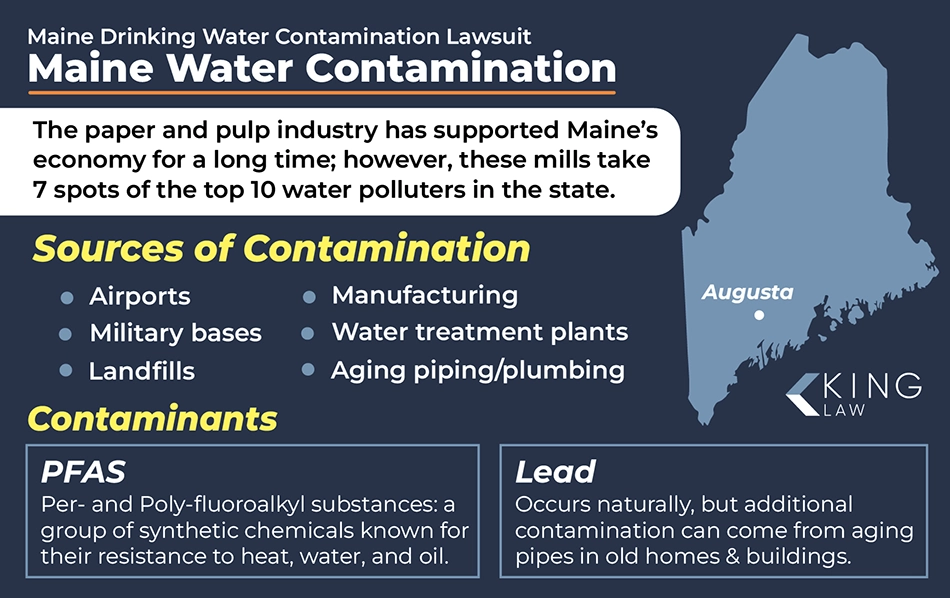
Sources of PFAS Contamination in Maine
One of the most concerning sources of water contamination in Maine is per- and polyfluoroalkyl substances (PFAS). One of the main sources of PFAS contamination is PFAS-containing firefighting foam (AFFF), which is used to extinguish fuel-based fires. This is why heavy contamination is found mainly around military bases and airports. Rainwater can dilute the foam, causing it to break down enough to get into groundwater and wells. However, PFAS do not completely break down, earning them the nickname “forever chemicals.” These chemicals have been found in water supplies near military installations throughout Maine.
Maine Airports with confirmed high PFAS contamination include:
- Bangor National Airport (2017): 55.1 parts per trillion (ppt) for total PFAS
- Houlton International Airport (2020): 70.6 ppt for PFOS
Maine Military Bases with confirmed high PFAS contamination include:
- Bangor Training Site (2022): 3,210 ppt for PFOA and 58 ppt for PFOS
- Brunswick Naval Air Station (2016): 24,000 for PFOS+PFOA
- Navy VLF Transmitter Cutler (2018): 360 ppt for PFOS+PFOA
- Loring Air Force Base (2018): 8,936 ppt for PFOS+PFOA
- Portsmouth Naval Shipyard (2018): 140 ppt for PFOS+PFOA
Other significant PFAS test results at various Maine locations include:
- Houlton Mobile Home Park (2022): 183 ppt for PFOS+PFOA
- Trenton School (2020): 53 ppt for PFOS+PFOA
- Kennebec Water District (2023): 10 ppt for PFOS+PFOA
- Sanford Water District (2023): 31 ppt for PFOS+PFOA
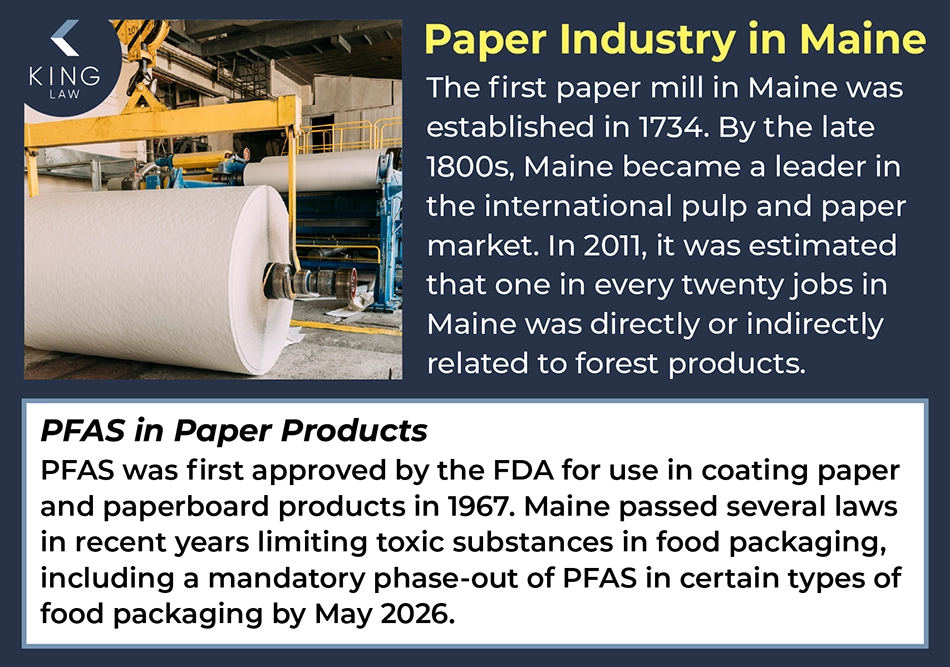
Maine’s Regulations for Drinking Water
Since 2019, the state of Maine has been conducting voluntary testing for PFAS in drinking water sources. In collaboration with the U.S. EPA and Maine Department of Environmental Protection (DEP), the Maine legislature established protocols and standards for the state’s public drinking water supplies. Maine residents can review their district’s water quality report.
In 2021, the Act to Stop Perfluoroalkyl and Polyfluoroalkyl Substances Pollution was passed and took effect on January 1, 2022. This law strongly restricts the sale and use of PFAS substances. In some cases, the manufacturer of a product containing PFAS must provide written notification to the consumer, detailing the purpose of the PFAS in the product and the amount of each type of PFAS used. In other cases, items such as carpets, rugs, or fabric treatments are completely banned from sale if they contain PFAS.
Maine Water Contamination Map
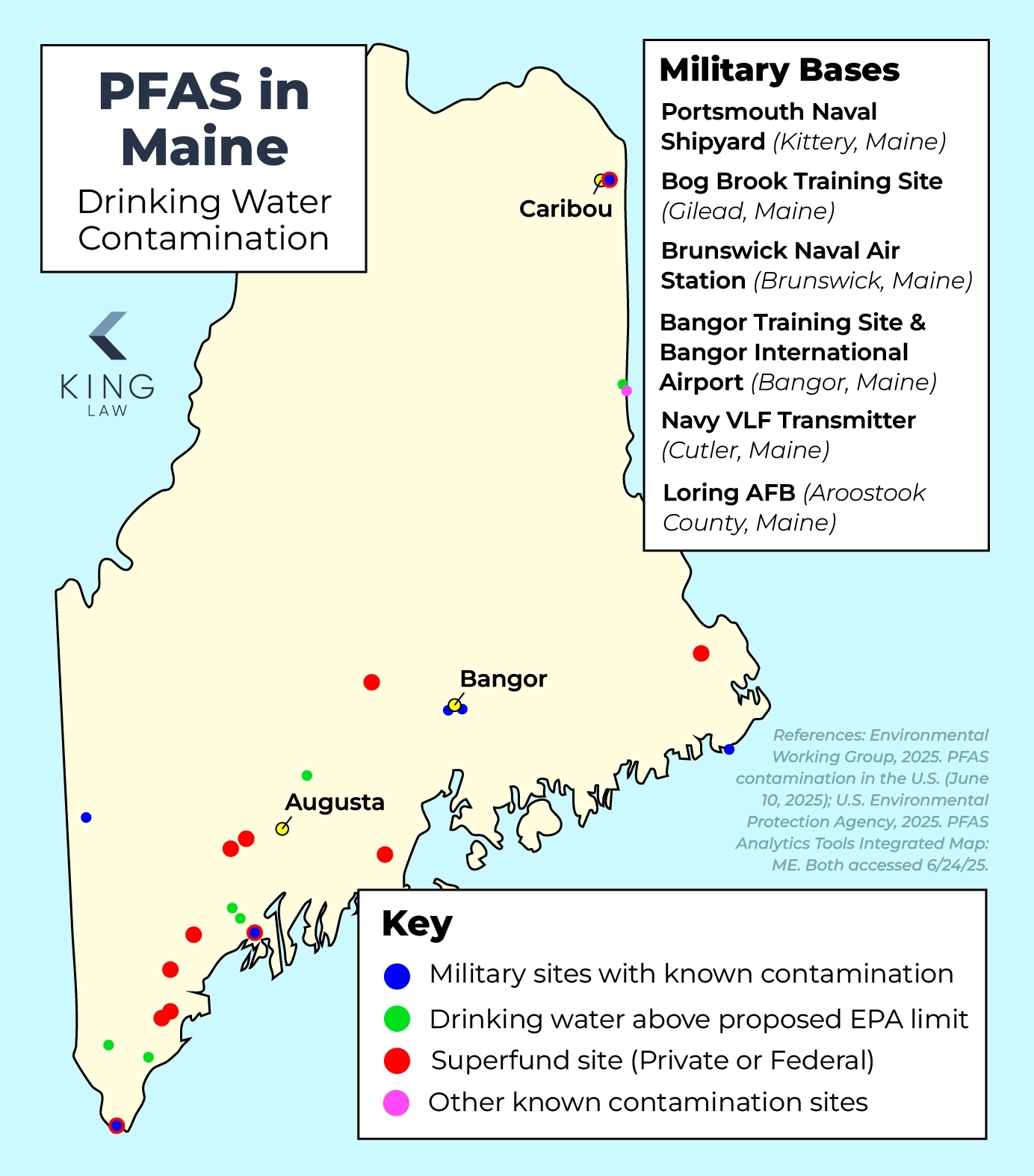
Our water contamination map shows areas where PFAS have been detected in Maine’s drinking water. Areas with high levels of water contamination are often found on or near military bases. Most of this contamination comes from AFFF Foam used on military bases and airports and sewer sludge used as fertilizer on farms. PFAS and other contaminants can spread throughout the water system, increasing contamination proximity over time.
Contaminants Found in Maine’s Drinking Water
Public drinking water and wells in Maine are contaminated with a variety of heavy metals (e.g., copper and lead) and PFAS. Various types of PFAS remain a significant concern throughout the state of Maine. Some of the most commonly detected types in Maine’s drinking water include PFOA, PFOS, PFBS, and PFHxS. Additionally, lead continues to be a notable contaminant. At elevated levels, lead can lead to numerous health issues, particularly affecting childhood development.
Per- and Polyfluoroalkyl Substances (PFAS)
Per- and polyfluoroalkyl substances (PFAS) can contaminate drinking water in Maine via multiple pathways. Firefighting foam and sludge used as fertilizer are the main sources of contamination. PFAS is a primary component of AFFF Foam, widely used in firefighting training and emergency responses at military and industrial facilities. Meanwhile, farmers used PFAS-contaminated sewer sludge as manure in their fields. Chemicals from the foam and sludge may seep into the ground, contaminating soil and groundwater, and ultimately affecting drinking water supplies.
PFAS are well-known for their persistence in the environment and the human body, leading to their nickname “forever chemicals.” Exposure to PFAS is associated with various health risks, including an elevated risk of cancers such as kidney, liver, and testicular cancer, thyroid disorders, and ulcerative colitis. PFAS contamination has led many individuals and municipalities to file lawsuits against PFAS manufacturers.
PFAS water contamination is a concern throughout the state of Maine. Unsafe levels of these chemicals in drinking water are linked to people developing:
- Birth defects
- Bladder cancer
- Breast cancer
- Changes in liver enzymes
- Decreased vaccine effectiveness
- Hodgkin’s and non-Hodgkin’s lymphoma
- Leukemia
- Lowered immune response
- Multiple-myeloma
- Kidney cancer
- Liver cancer
- Pancreatic cancer
- Prostate cancer
- Reproductive issues
- Testicular cancer
- Thyroid cancer
- Thyroid disease
- Ulcerative colitis
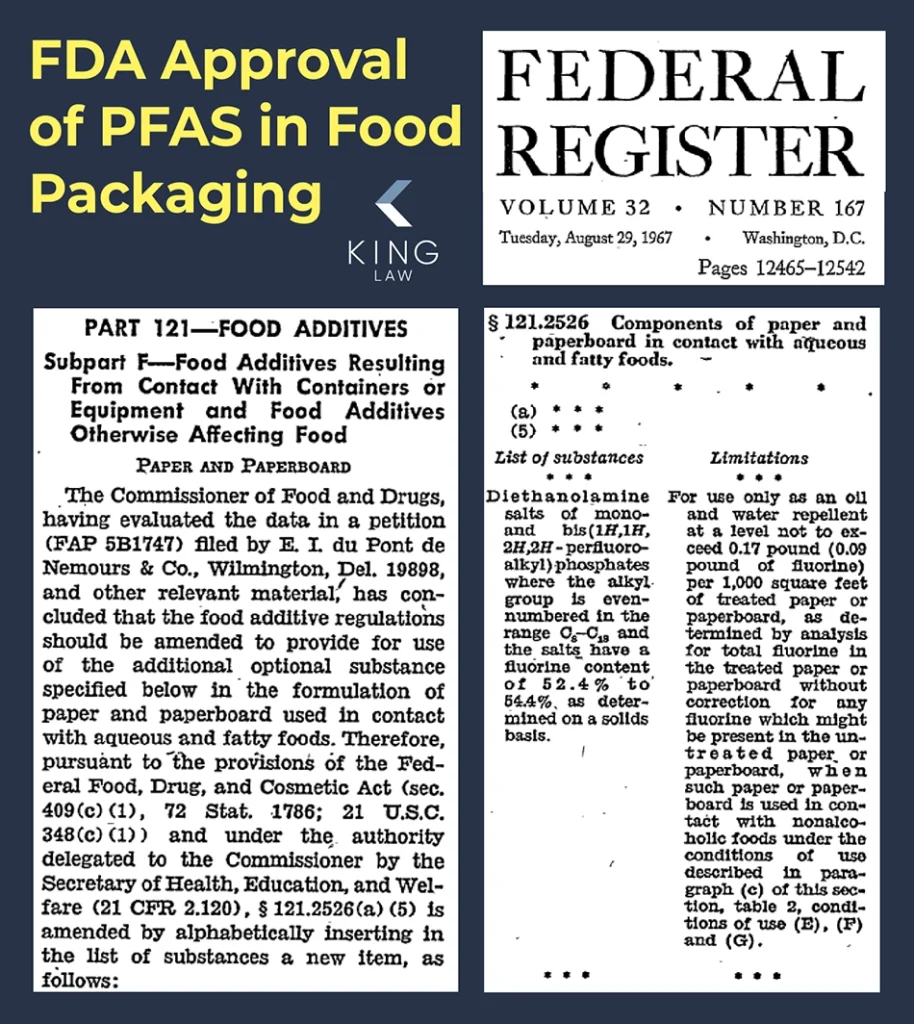
Lead
Lead is another concern when it comes to drinking water. It is not typically found in source water, but contamination can occur through the corrosion of pipes and plumbing fixtures. Elevated lead levels can lead to lead poisoning, particularly in young children. To prevent this risk, in 2022, the Maine Legislature mandated that all K-12 schools test their drinking water for the presence of lead under the Maine Public Law 2019 Ch. 158- An Act To Strengthen Testing for Lead in School Drinking Water.
Current Water Quality in Maine
Water quality in the state of Maine varies by district and the source of the water. For example, 1 in 10 wells in Maine are polluted and have too much arsenic, uranium, radon, or other harmful chemicals. Similarly, mandated water quality testing has found many locations in Maine exceeding water quality standards for PFAS, including schools, water districts, apartment complexes, childcare centers, and trailer parks.
Water Treatment Efforts in Maine
Government officials and nonprofits in Maine are working to address water quality issues. The Drinking Water State Revolving Fund (DWSRF) is designed to provide financial assistance to Maine public water systems. This can be for projects such as upgrading water system pipes and treatment plants, or for non-construction projects like source water protection.
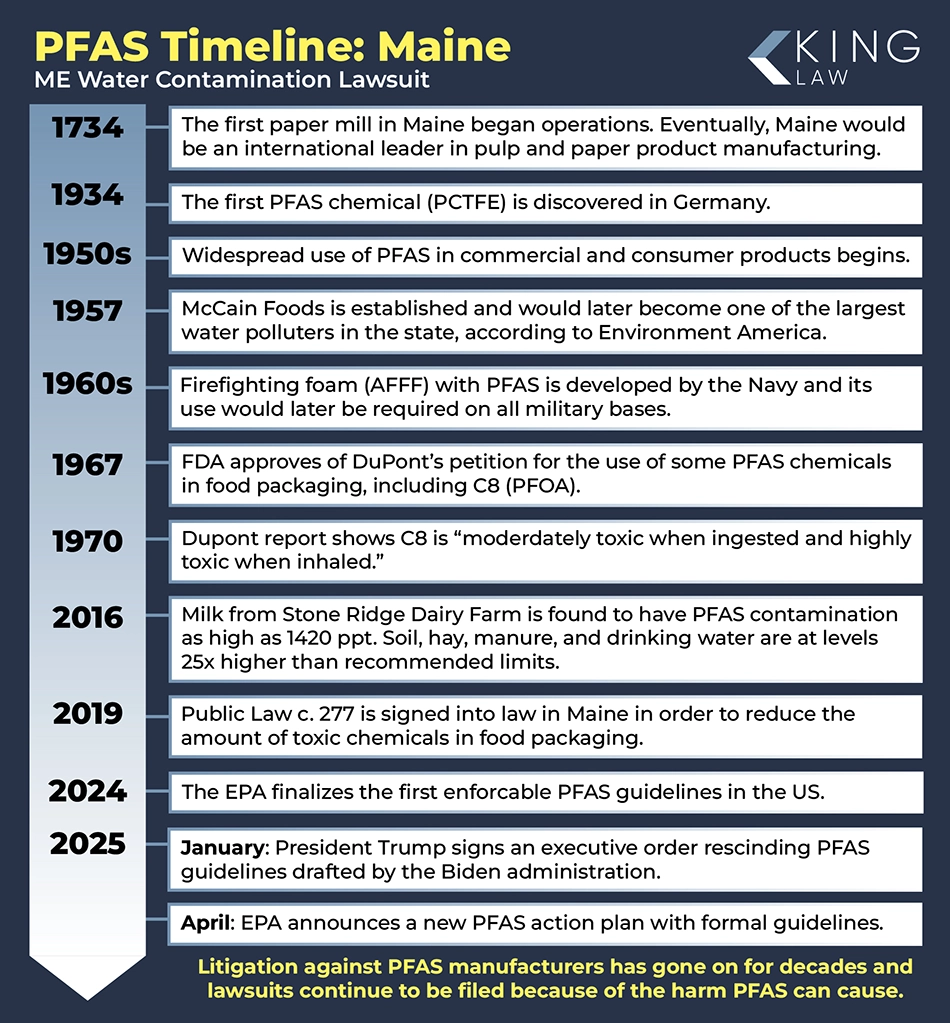
Health Risks and Symptoms Linked to Drinking Water in Maine
Multiple types of cancers and diseases are associated with drinking contaminated drinking water. Heavy metals exceeding unsafe levels in drinking water can cause developmental, neurological, organ, and reproductive harms. PFAS in drinking water can cause people to develop cancer, thyroid disease, and ulcerative colitis.
Ulcerative Colitis is a kind of inflammatory bowel disease that affects the colon and rectum. Symptoms, including urgency to pass stool but inability to, fatigue, fever, and rectal pain, typically develop gradually rather than suddenly. It is best to see a doctor if there has been a noticeable, lasting change in bowel habits.
PFAS exposure can be linked to other various health conditions such as:
- Kidney Cancer
- Testicular Cancer
- Thyroid Cancer
- Thyroid Disease
- Ulcerative Colitis
- Prostate Cancer
- Liver Cancer
- Men’s Breast Cancer
- Reproductive Issues
- Leukemia
Eligibility Criteria for the Maine Water Contamination Lawsuit
To qualify for a water contamination lawsuit in the state of Maine, individuals need to meet certain criteria:
- Duration of Exposure: During the specified contamination period, individuals should have lived or worked in the state for a minimum of 1 year.
- Specific Diagnoses: Our firm is assessing cases with the following diagnoses:
- Supporting Documents: Required documentation consists of medical records validating diagnoses and evidence of residency or employment during the contamination period (for example, utility bills, lease agreements, or government/military documents). These elements are vital for constructing a strong legal claim. Consulting with specialized attorneys, such as those at King Law, may help to navigate the legal process efficiently.
Maine Water Contamination Settlement and Payout Amounts
Settlement amounts differ on a case-by-case basis. Our team expects most settlements to range between $30,000 and $300,000, depending on the diagnosis type and its effects on someone’s life. Other factors such as age and medical expenses may also affect compensation.
Once trials for PFAS Water Contamination begin, we will better understand what settlement amounts will look like. It is important to remember that potential trial verdicts are typically greater than settlements, as they balance risk and reward.
How to File a Maine Water Contamination Lawsuit
Filing a personal injury lawsuit against large companies, such as 3M, DuPont, or Chemours, can be intimidating. An attorney can offer guidance and establish practical expectations regarding the timeline of the lawsuit and its outcome. Here is a step-by-step guide on what the process will most likely look like:
- Intake Consultation: Find a knowledgeable law office specializing in environmental and personal injury law. The initial consultation can take up to 15 minutes and will help determine the strength of your claim.
- Gather Evidence: Though your attorney will clarify what exactly will be needed for evidence in your case, start considering what proof you have to show residency or employment in the contaminated area and proof of diagnosis.
- Filing Your Case: Your lawyer will file the necessary paperwork, such as a complaint form highlighting the allegations and damages sought.
- Settlement Negotiations: Your attorney will initiate negotiations to secure a fair settlement. Your attorney will not agree to any settlement without your approval, ensuring you receive full compensation for your injuries endured.
- Trial: The case will go to trial if a settlement cannot be reached. Your attorney will bring the evidence in front of a judge or jury to determine your case.
An attorney experienced in environmental regulations and personal injury lawsuits can be incredibly beneficial for you and your case. The legal system is confusing; having a lawyer guide you through the process makes it much less complex.
Evidence to Support Your Maine Water Contamination Claim:
After meeting with an attorney, you will better understand what exactly will be needed to prove your case. However, it is important to consider what evidence you can provide to make the process more efficient. Key types of evidence can include:
- Medical Records: Any documentation related to the diagnosis will help with compensation. This can include the type of diagnosis, treatments, and treatment recommendations.
- Proof of Exposure: Documents like lease agreements, utility bills, or employment records during the contamination period will help prove you have been exposed.
- Environmental Reports: Studies and samples taken of the area that show the amount of contamination in the water.
- Personal Statements: Comprehensive descriptions of the exposure type and the effects of the diagnosis on your daily life.
- Medical Bills: Items such as insurance statements, receipts, or bills for medical treatments and other related healthcare costs related to the diagnosis.
Documentation is one of the most significant sources of evidence in water contamination cases. Gathering and organizing evidence will prove the validity of your case and be essential in providing the desired outcome.
Statute of Limitations for Maine Water Contamination Claims
The statute of limitations is a legal timeline that changes from state to state. To potentially receive compensation, a personal injury claim must be submitted within a specific time. In Maine, the statute of limitations for personal injury cases is typically 6 years.
However, these limits can vary depending on the case’s specifics. The best way to determine the statute of limitations for your case is to speak with an experienced attorney. There may be exceptions in cases where people only recently learned that PFAS water contamination might be the source of their injuries.
Maine Water Contamination Lawyers
The attorneys at King Law Firm have extensive experience with environmental cases, particularly those involving water contamination. Our background in personal injury lawsuits allows us to understand all the specifications of these cases. Our team offers a deep understanding of the challenges each potential client is going through, and we are here to help.
During a free consultation, we will gain a clear understanding of your case, your eligibility, and the timeline for the next steps in the process. Our lawyers will continue to keep you updated throughout the process and will file all legal claims within the appropriate timeframe to meet deadlines. Contact us today for your free consultation.
Frequently Asked Questions (FAQs)
Discover more about water contamination in Maine by reviewing these commonly asked questions:

